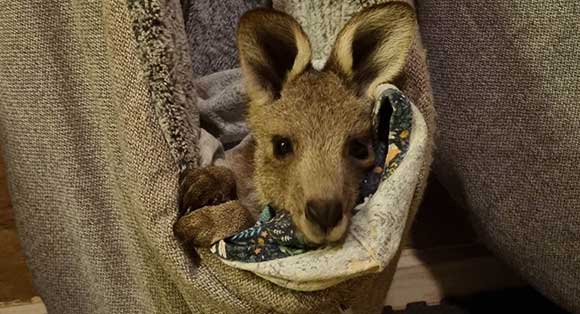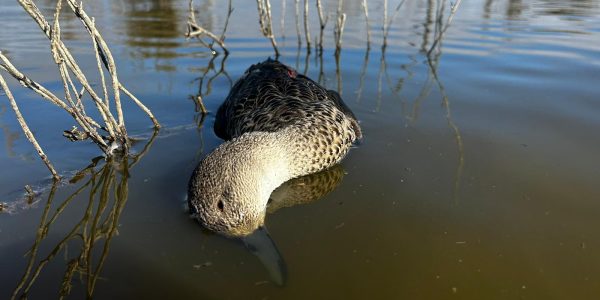Section one:
Preliminary Questions
“The goal of the Victorian Kangaroo Harvest Management Plan is to provide for the sustainable use of kangaroos in a way that protects animal welfare. The goal makes clear that sustainable kangaroo populations and good animal welfare outcomes are the highest priorities.”
Do you agree with the goal of the KHMP?
- I fundamentally disagree with the goal of the KHMP and completely oppose the commercial exploitation of native Australian wildlife purely for money – kangaroo slaughter is being fuelled by the unnecessary international trade in kangaroo leather and meat products.
- The ‘sustainability’ aspect of the KHMP goal is a fallacy; when kangaroo populations are based on unreliable estimates, there can be no ‘sustainable number’ of kangaroos killed. Victoria’s kangaroos are a critical part of our biodiversity, and killing them on such a large scale will have a dire impact on the broader ecosystem.
- The idea of killing kangaroos in a way that ‘protects animal welfare’ is contradictory; the wildlife trade is inherently cruel, particularly when it involves the wounding of animals, the disruption of kangaroo family and social structures, and the decapitation or bludgeoning of vulnerable joeys after their mothers have been shot on a mass scale.
In your opinion do you think the KHMP achieves its goal?
- No. I strongly believe the KHMP is enabling an unavoidably irresponsible and cruel wildlife trade that should not be allowed to operate in our state.
- The KHMP cannot achieve its sustainability goal when basing decision making and evaluation on data from unreliable methodologies, as government surveys are based on extrapolating data from small aerial transects. An outdated criteria is being used for what constitutes ‘sustainable’ and it does not consider the ongoing stressors to kangaroo populations, including habitat loss and fragmentation, climate change, and disease, in addition to the continuation of a commercial shooting industry. Therefore, there should be no slaughter of kangaroos on the basis of the currently available data which is inevitably inaccurate.
- ‘Animal welfare’ goals cannot be achieved while animals are being shot, bludgeoned or decapitated – under the current national Code of Practice, immeasurable suffering is caused to kangaroos shot and their pouch and at-foot joeys who are killed brutally as collateral damage.
- The commercial kangaroo shooting industry is operating under the cover of darkness with no oversight on the ground – making proper regulation or compliance impossible.
[1] Ensure that commercial kangaroo harvesting in Victoria is ecologically sustainable.
Is this objective being met?
Are the requirements for meeting this objective appropriate?
What other requirements might be needed to meet this objective?
- There should be no slaughter of kangaroos based on data from the current deeply flawed population models. The term ‘sustainable’ is misleading especially until kangaroo populations can be accurately reported on.
- Rapid disaster triggers must be established and implemented into the KHMP. As seen following the 2020 black summer fires and the 2022 flood emergency in VIC, there is no effective monitoring or reporting on localised populations of kangaroos impacted by disasters. The absence of ‘disaster overlays’ poses a serious risk of localised extinctions when shooting continues in these areas or when future annual quotas do not take disasters into consideration.
- The knowledge and expertise of local governments must be factored in. Currently, this critical resource of information is being ignored. For example, the current harvest zone boundaries include some areas on the fringes of Melbourne such as the Mornington Peninsula and Nilumbik, where kangaroo populations are condensed into small land areas due to urban development. Shooting kangaroos in regions like these puts populations at risk of localised extinction. Therefore, local governments and wildlife organisations should be consulted on exemption zones in the name of ‘sustainability’.
Are the targets and management actions appropriate measures for achieving these requirements?
What other targets or indicators might be necessary for existing requirements?
- The only responsible target for native wildlife sustainability is the immediate termination of the commercial kangaroo industry in Victoria and a focus on respectful coexistence with wildlife.
- Population model methodology and population counts should be published clearly on the DELWP website and kept up to date.
- An accurate and fully transparent kangaroo counting method must be employed as soon as possible.
- A clear criterion to assess a major event or natural disaster to determine whether a kangaroo population count must occur, which may lead to a cessation of the KHMP.
[2] Ensure that commercial kangaroo harvesting in Victoria is humane and animal welfare is protected.
Is this objective being met?
Are the requirements for meeting this objective appropriate?
What other requirements might be needed to meet this objective?
- The KHMP, by its inherent nature, cannot align with relevant welfare legislation such as the ‘Prevention of Cruelty to Animals Act’ (POCTA), as the plan causes animal suffering on a massive scale. Allowing kangaroos to be shot, and joeys to be bludgeoned to death or to die slow, painful deaths without maternal care if they escape, is at odds with ‘protecting animal welfare’.
- The treatment of kangaroos must be required to meet community standards. The continued slaughter of hundreds of thousands of kangaroos for profit is not consistent with community expectations in Victoria, nor does it comply with contemporary animal welfare science, ethics, conservation science, or national and international obligations.
- Given the Code of Practice recommends the following method to kill joeys, commercial shooting should not continue in Victoria as the fear, distress and suffering it causes is inhumane and unacceptable: “Hold the young firmly by the hindquarters (around the top of the back legs and base of tail) and then swing firmly and quickly in an arc so that the rear of the joey’s head is hit against a large solid surface that will not move or compress during the impact (e.g. the tray of a utility vehicle)”.
- The Code of Practice requirement to kill kangaroos with a headshot that ‘destroy(s) the vital areas of the brain’ is inadequate as the neck can be severed close to the shoulders, removing evidence of kangaroos shot in the face and neck.
Are the targets and management actions appropriate measures for achieving these requirements?
What other targets or indicators might be necessary for existing requirements?
- The only ethical target for the humane treatment of wildlife is the immediate termination of the commercial kangaroo industry in Victoria and a focus on respectful and compassionate coexistence with wildlife.
- The target goals indicate that 100% of new shooters will hold a firearms proficiency accreditation, will have completed a recognised Game Harvester competency program, or have a valid firearms licence. There is no mention of this same requirement for existing shooters, which should also be necessary as a bare minimum.
- The target, “100% of reports of non-compliance are investigated and appropriate action taken where possible” is not feasible when compliance is entirely self-regulated. Ensuring compliance would, at minimum, require a compliance officer to be present or viewable / independently monitored body-camera footage to be available so that compliance/non-compliance can be monitored in the first place.
[3] Ensure that commercial kangaroo harvesting and processing activities are appropriately regulated.
Is this objective being met?
Are the requirements for meeting this objective appropriate?
What other requirements might be needed to meet this objective?
- Given commercial shooting happens at night, the National Code of Practice that is meant to apply to the commercial industry in Victoria is impossible to effectively enforce – meaning there is no effective oversight.
- There is no oversight or reporting of mis-shot and wounded animals who are not killed outright, including dependent young who are orphaned because of commercial shooting.
- The requirement to hold appropriate licences is indicative only of a person’s ability to do their paperwork and not of their ability to comply with guidelines, codes of practice or any form of ethical behaviour, therefore it is not of use in regulating behaviour. There must be a requirement to explain clearly how the KHMP will be monitored to ensure compliance with regulations.
- In the process of licencing commercial shooters, there are currently no requirements for applicants to prove they have no previous violations of the Code of Practice, or previous convictions under other anti-cruelty legislation (e.g., POCTA). Commercial shooters should be required to disclose this information, and be unable to obtain a licence if previous violations or convictions exist.
Are the targets and management actions appropriate measures for achieving these requirements?
What other targets or indicators might be necessary for existing requirements?
- As it is not feasible to monitor all shooting activity in every location, effective regulation is not possible. The only ethical and responsible target is the immediate termination of the commercial kangaroo industry in Victoria.
- Every ‘harvest’ should have a compliance officer present as a bare minimum as it is futile and expensive to waste taxpayer dollars on bureaucratic processes to develop written regulations that are unenforceable in the field.
Please remember to write responses in your own words – do not copy and paste these points. Personalised responses will have much more impact for kangaroos.
[4] Effectively monitor and enforce compliance.
Is this objective being met?
Are the requirements for meeting this objective appropriate?
What other requirements might be needed to meet this objective?
- There is no way of enforcing the Code of Practice – there is a complete and unacceptable lack of regulatory oversight and enforcement given commercial shooting occurs at night in remote areas. Plus, the Code acknowledges that wounding occurs, that bludgeoning joeys ‘humanely’ depends on the skill of the shooter, and that at-foot joeys often flee and can experience ‘considerable suffering’ without their mothers. The KHMP finds this level of cruelty to be acceptable, which is at odds with the expectations of the Victorian community.
- As the industry is entirely self-regulated, data provided on numbers of animals shot is self-reported. There should be a requirement for transparent data on the number of kangaroos killed, with a compliance officer present during every ‘harvest’.
- There is no mechanism or requirement to advise neighbouring residents of an impending shoot, leading to inevitable safety risks and distress for local community members.
- The sheer scale of the industry and the mobility of kangaroo populations make it difficult to ensure compliance with regulations and to detect and address any violations. Any efforts to address this issue – whether stricter regulations, enhancing transparency, investing in improved monitoring technologies, and promoting dialogue between stakeholders – cannot ensure ethical practices in an industry that operates remotely in the cover of darkness.
Are the targets and management actions appropriate measures for achieving these requirements?
What other targets or indicators might be necessary for existing requirements?
- Compliance cannot be effectively monitored, therefore the only ethical and responsible target is the immediate termination of the commercial kangaroo industry in Victoria.
- To address the complete lack of monitoring and compliance checks, body cameras should be a requirement for all shooters during commercial ‘harvests’, with footage made available to the public for transparency.
- Stating that 100% of reports of non-compliance will be investigated is misleading. Investigations rarely occur in real time, so the ability to follow up relies on the ‘evidence’ of shooter identity collected by residents. Since kangaroo shooting occurs in darkness, the ability of members of the public to obtain evidence of a high enough quality to enable follow up is unlikely. Without widespread, regular monitoring every night across the entire state, this target is meaningless and unactionable.
[5] Facilitate adaptive management and research.
Is this objective being met?
Are the requirements for meeting this objective appropriate?
What other requirements might be needed to meet this objective?
- Despite widespread and ongoing community concerns and evidence of the failings of the law to prevent suffering caused by the commercial kangaroo shooting industry, the government persists with its support of the industry. This directly contradicts the Department’s objective of facilitating adaptive management and research.
- It is wasteful and irresponsible to spend taxpayer dollars on adaptive management research for an industry that is risking community health, actively destroying our natural heritage, and impacting negatively on our international reputation.
Are the targets and management actions appropriate measures for achieving these requirements?
What other targets or indicators might be necessary for existing requirements?
- With wildlife populations navigating the impacts of habitat loss and destruction due to urban sprawl and climate crises, research should focus on ensuring native species survive and thrive. The only ethical and responsible target is the immediate termination of the commercial kangaroo industry in Victoria and a focus on respectful coexistence with wildlife.
[6] Maintain openness, accountability and transparency.
Is this objective being met?
Are the requirements for meeting this objective appropriate?
What other requirements might be needed to meet this objective?
- Transparency hasn’t been established within the KHMP, therefore more needs to be done before it is maintained.
- There is currently no accurate figure for total kangaroos killed in the state due to commercial and non-commercial kangaroo killing combined, as no data is collected on the actual number of kangaroos killed under the ACTW system. This combined data must be collated and made public.
- It is very difficult to obtain transparent information about how kangaroo population survey methodologies are calculated. This information should be disclosed clearly to the public immediately.
- It is very difficult to obtain data on the specific location of permits granted under the KHMP. In the name of openness and accountability, this should be disclosed for the safety, security and full amenity of all land managers in surrounding areas, especially registered wildlife shelters.
- The KHMP presents itself as a necessary way of managing kangaroo populations, however kangaroos don’t need to be managed. Kangaroos have been managing their own populations for an estimated 20 million years, mostly without a major top-down predator. This is a commercial enterprise and the plan needs to be clarified and renamed to reflect its true goals and objectives – which is profit-driven.
Are the targets and management actions appropriate measures for achieving these requirements?
What other targets or indicators might be necessary for existing requirements?
- The only ethical and responsible target is the immediate abolition of the commercial kangaroo industry in Victoria and a focus on respectful coexistence with wildlife.
- A customer contact centre for providing feedback will only meet requirements for ‘openness and accountability’ if it is staffed 24 hours a day, 7 days a week, with sufficient staffing of officers available to visit incidents immediately to investigate and take action. The resource and financial costs to provide this are potentially prohibitive, but anything less is inadequate.
- The introduction of mandatory consultation and approval from neighbouring properties, to enable the ability to oppose the operation of commercial shooting in their immediate surrounds, should they wish.
[7] Work with Traditional Owners to provide opportunities for participation.
Is this objective being met?
Are the requirements for meeting this objective appropriate?
What other requirements might be needed to meet this objective?
- The Department must first formally recognise that First Nations people have diverse and valuable perspectives on the killing of kangaroos – all views, including those opposed to the commercial killing of kangaroos, should be acknowledged.
- There should be a requirement to avoid causing cultural offence. Kangaroos are a Creator Spirit and Sacred Totem for many First Nations people, holding deep cultural significance. In light of this, the KHMP will inevitably cause distress to those who oppose the commercial killing industry as culturally offensive and/or as a vestige of colonial exploitation. These viewpoints should be recognised and respected.
- Whilst First Nations people are granted rights to hunt kangaroos under the ‘Native Titles Act 1993’ for ‘traditional purposes’, the KHMP is a commercialised kangaroo killing industry and any attempt to appropriate the cultural practices of First Nations people as a justification for a profit-driven industry is unacceptable.
Are the targets and management actions appropriate measures for achieving these requirements?
What other targets or indicators might be necessary for existing requirements?
- The only ethical and responsible target is the immediate termination of the commercial kangaroo industry in Victoria and a focus on respectful coexistence with wildlife.
- A publicly available registry of Aboriginal organisations that have been consulted, and evidence that they have been provided information that accurately represents the inherent welfare, sustainability and hygiene concerns, as well as the concerns of Aboriginal activists opposed to the trade.








